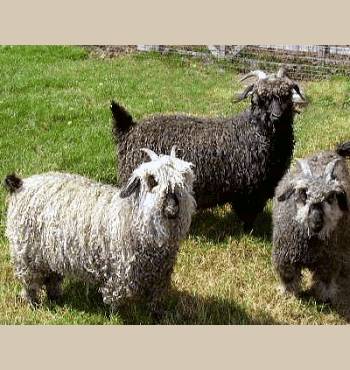Silver R/B/B pool goat (with frosted ears and nose)
Red Black Brown Pool:
The Red/Black/Brown Pool (R/B/B) gets is color from genes located on the Extension locus. This color locus is more dominant than the Black/pattern pool agouti locus. Goats in this pool are typically a shade of red, black or brown as the name describes. The black often fades to gray. These goats are usually a solid color, but may have some variation of the shade of that color in their fleece. They do not have the predictable patterns present in the black/pattern pool. White spotting patterns do occur in these goats (in the black/pattern pool as well), but that is controlled by a different set of genes.
Reading through the pedigree is the easiest way to see which pool (or the potential for both pools) the goat will likely produce color with. For the R/B/B pool, look for these colors in the pedigree. A predominance of these colors increases the likelihood that the goat will produce color when bred to another goat in this pool.
Reds, blacks and brown goats can produce any of the 3 colors. Genetically, brown in the red/black/brown pool is actually a shade of red.
Brown goats in the Red/black/brown pool can be differentiated from brown goats that get their color from the Brown locus by checking for black fibers. The Brown locus changes normally black color in a goat to a shade of brown, so no black will be present on a goat. R/B/B pool browns will typically have black hairs somewhere on their body. These hairs can be found in the fleece on some goats, but are easiest to see on the tail, legs and face. Presence of black hair shows that the goat is in the red/black/brown pool, because black can not be present on a brown locus goat. However, the inability to find black hairs does not prove that the goat's brown color is from the brown locus. At this time, brown angora goats are most likely a shade of red. The best way to eventually prove that a goat gets brown color from the brown locus would be to have a reverse badger where the black areas are instead a shade of brown. (brown or tan at the normally light white area does not qualify.) Toggenburg dairy goats are a good example of brown locus brown goats.





